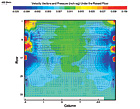
This data center room’s computational fluid dynamics (CFD) analysis demonstrates the various temperatures electronic equipment experiences throughout a space. The red airflow patterns are unacceptable hot spots of 95°F or more, whereas the cooler green is in the acceptable temperature range of 65° to 75° and the blue airflow shows, an acceptable, but very inefficient 55° or lower.
It’s a natural reaction. Information technology (IT) equipment overheats in a particular rack and the data center manager assumes more tons of air conditioning is needed even though the room set point temperature is maintained at the recommended 72°F.
Several more 10-ton precision a/c units are expensively added, but electronic equipment continues to fail because the underlying problem is inadequate supply air distribution to the equipment rack.
Or in another scenario, the manager pinpoints a hot spot either by observation or with a sensor. To alleviate the problem, the a/c equipment is dialed down to discharge temperatures lower than the 55° to 60° recommended by the American Society of Heating, Refrigerating & Air-Conditioning Engineers (ASHRAE).
The hot spot is eliminated, but now the entire room is running too cold. This puts unnecessary wear on the a/c equipment. Since a/c systems also sense and control relative humidity to an optimum 50 percent rh, the lower temperatures increase rh and consequently run longer on dehumidification cycles.
This scenario is increasingly played out in data centers across the world as Internet server rooms, broadcast centers, electronic vaults, and other high-tech categories mass together hundreds and sometimes thousands of pieces of heat-generating equipment that must all be cooled equally in one space.
MODELING TO THE RESCUE
Mission critical air conditioning equipment manufacturers are coming to the rescue with computational fluid dynamics (CFD) or modeling analysis that can pinpoint hot spots in rooms, and even within the equipment racks themselves.Air distribution in data centers relies on three methods: overhead ducted systems, underfloor supply, and free-blowing ambient air techniques from the a/c units themselves. The underfloor supply (sometimes referred to as a subfloor plenum) is by far the most popular air distribution methodology, with about a 75 percent market share.
There are a multitude of reasons the conditioned air doesn’t reach a particular piece of equipment:

Snapshot of current conditions of the data center’s subfloor static pressure (shown with varying colors) and air velocity (represented as varying sized arrows). Six CRAC units are running, with two units off for redundancy marked with an X.
• A room reconfiguration, which is common in data centers, might have repositioned a rack too remotely from the airstream.
• Air obstructions might exist within the rack.
• The underfloor system needs air balancing.
• Obstructions such as support columns and/or utility piping, might deflect the airflow.
Regardless of the reason, many data center managers end up with a nice CFD analysis and no physical retrofit solution. However, some contractors are now developing actual solutions.

The same data center with Technology Connection’s subfloor air-balancing system in place. An additional CRAC unit turned off allows three units to be used as redundancy, creating a large energy savings while balancing the entire subfloor airflow. The uniform color represents balance in the subfloor static pressure (the color scale has changed; the static pressure has drastically increased even with an additional unit turned off). Greater static pressure correlates directly to increased airflow through perforated tiles.
CONTRACTOR'S SOLUTIONS
Technology Connection (TC), a Wixom, Mich.-based contractor specializing in airflow balancing and efficiencies for IT infrastructure, developed proprietary overlay software that complements a CFD analysis.The FlowLogix software specifies what size and where to position a variety of restriction and baffle devices it custom-fabricates to balance airflow supply in dysfunctional subfloor plenums, as well as overhead ducted systems. The devices create an even air pressure throughout the subfloor, so the air is distributed more evenly through the perforated diffusion tiles.
Obviously, the most important issue to data center managers is protecting electrical equipment from premature failure. However, another underlying issue is energy conservation. The aforementioned technique of adding more tons of a/c not only doesn’t solve the source problem, which is typically air balancing, but also can double and triple a data center’s energy costs.
This is all the more reason for first examining the ventilation system with CFD analysis, then making the necessary improvements with air balancing for a total ventilation improvement.
Publication date:04/19/2010

Report Abusive Comment